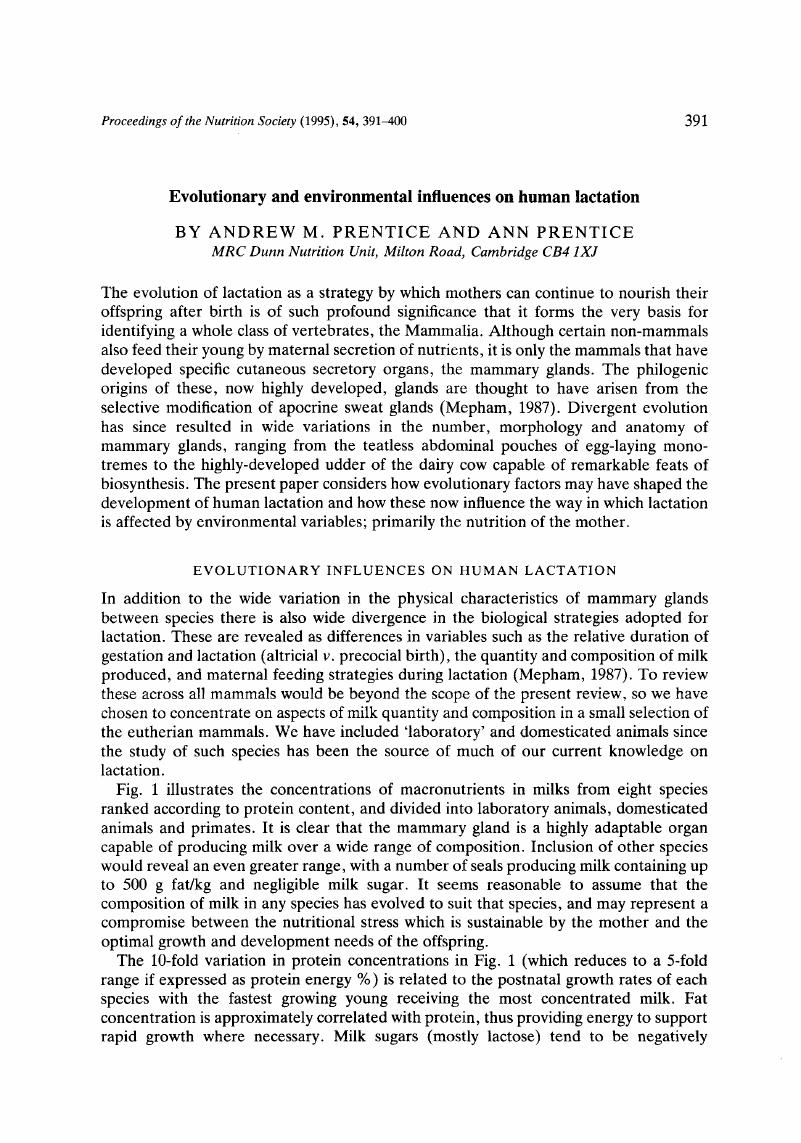Crossref Citations
This article has been cited by the following publications. This list is generated based on data provided by Crossref.
Prentice, Ann
1996.
Constituents of Human Milk.
Food and Nutrition Bulletin,
Vol. 17,
Issue. 4,
p.
1.
Wharton, B.
1996.
Recent Developments in Infant Nutrition.
p.
260.
Goldberg, Gail R.
1997.
Reproduction: a global nutritional challenge.
Proceedings of the Nutrition Society,
Vol. 56,
Issue. 1B,
p.
319.
Rashid, M.
and
Ulijaszek, Stanley J.
1999.
Daily energy expenditure across the course of lactation among urban Bangladeshi women.
American Journal of Physical Anthropology,
Vol. 110,
Issue. 4,
p.
457.
2002.
Demography and Nutrition.
p.
340.
Fomon, Samuel J.
2004.
Assessment of Growth of Formula-Fed Infants: Evolutionary Considerations.
Pediatrics,
Vol. 113,
Issue. 2,
p.
389.
Symonds, Michael E.
2007.
Integration of physiological and molecular mechanisms of the developmental origins of adult disease: new concepts and insights.
Proceedings of the Nutrition Society,
Vol. 66,
Issue. 3,
p.
442.
Mannion, Cynthia A.
Gray-Donald, Katherine
Johnson-Down, Louise
and
Koski, Kristine G.
2007.
Lactating Women Restricting Milk Are Low on Select Nutrients.
Journal of the American College of Nutrition,
Vol. 26,
Issue. 2,
p.
149.
Kosanovic, Melita
Adem, Abdu
Jokanovic, Milan
and
Abdulrazzaq, Yousef M.
2008.
Simultaneous Determination of Cadmium, Mercury, Lead, Arsenic, Copper, and Zinc in Human Breast Milk by ICP‐MS/Microwave Digestion.
Analytical Letters,
Vol. 41,
Issue. 3,
p.
406.
Crittenden, Ross
and
Playne, Martin J.
2008.
Handbook of Probiotics and Prebiotics.
p.
533.
Symonds, Michael E.
and
Budge, Helen
2009.
Nutritional models of the developmental programming of adult health and disease.
Proceedings of the Nutrition Society,
Vol. 68,
Issue. 2,
p.
173.
Hinde, Katherine
2009.
Richer milk for sons but more milk for daughters: Sex‐biased investment during lactation varies with maternal life history in rhesus macaques.
American Journal of Human Biology,
Vol. 21,
Issue. 4,
p.
512.
McMullen, Sarah
and
Mostyn, Alison
2009.
Animal models for the study of the developmental origins of health and disease.
Proceedings of the Nutrition Society,
Vol. 68,
Issue. 3,
p.
306.
Gluckman, Peter D.
and
Hanson, Mark A.
2010.
The plastic human.
Infant and Child Development,
Vol. 19,
Issue. 1,
p.
21.
Hanley, Bryan
Dijane, Jean
Fewtrell, Mary
Grynberg, Alain
Hummel, Sandra
Junien, Claudine
Koletzko, Berthold
Lewis, Sarah
Renz, Harald
Symonds, Michael
Gros, Marjan
Harthoorn, Lucien
Mace, Katherine
Samuels, Fiona
and
van Der Beek, Eline M.
2010.
Metabolic imprinting, programming and epigenetics – a review of present priorities and future opportunities.
British Journal of Nutrition,
Vol. 104,
Issue. S1,
p.
S1.
Wilson, Warren M.
Bulkan, Janette
Piperata, Barbara A.
Hicks, Kathryn
and
Ehlers, Peter
2011.
Nutritional status of Makushi Amerindian children and adolescents of Guyana.
Annals of Human Biology,
Vol. 38,
Issue. 5,
p.
615.
Hayward, Adam D.
Holopainen, Jari
Pettay, Jenni E.
and
Lummaa, Virpi
2012.
Food and fitness: associations between crop yields and life-history traits in a longitudinally monitored pre-industrial human population.
Proceedings of the Royal Society B: Biological Sciences,
Vol. 279,
Issue. 1745,
p.
4165.
Low, Felicia M.
Gluckman, Peter D.
and
Hanson, Mark A.
2012.
Developmental Plasticity, Epigenetics and Human Health.
Evolutionary Biology,
Vol. 39,
Issue. 4,
p.
650.
Seidl-de-Moura, Maria Lucia
de Souza, Altay L.
Oliva, Angela Donato
Vieira, Mauro Luis
Lordelo, Eulina
Tokumaru, Rosana Suemi
and
Bandeira, Tatiana Targino Alves
2012.
Profiles of Maternal Care Observed in a Group of Brazilian Mothers: an Exploratory Study.
The Spanish journal of psychology,
Vol. 15,
Issue. 3,
p.
989.
Prentice, A.n.n.
2012.
Pediatric Bone.
p.
223.



